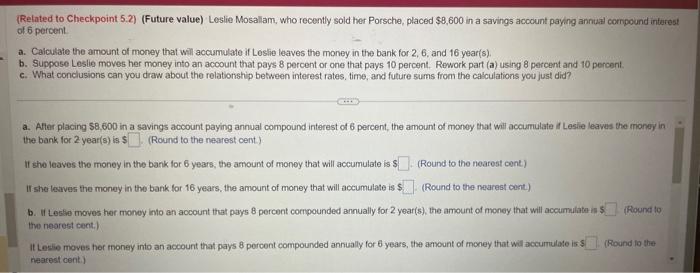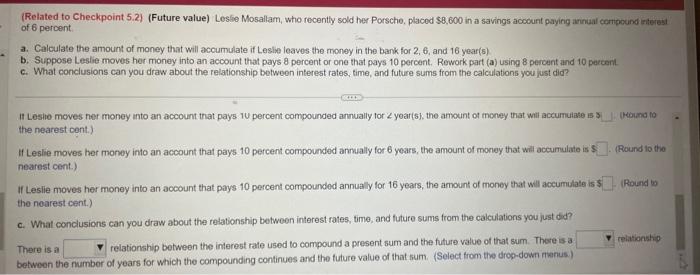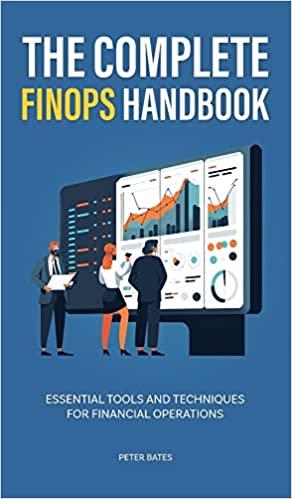(Related to Checkpoint 5.2) (Future value) Leslie Mosallam, who recently sold her Porsche, placed $8,600 in a savings account paying annuat connpound interest of 6 persent. a. Caiculate the amount of money that will accumulate if Leslie leaves the money in the bank for 2,6 , and 16 year(s). b. Suppose Leslie moves her money into an account that pays 8 percent or one that pays 10 percent. Rework part (a) using 8 percent and 10 percent. c. What conciusions can you draw about the relationstip between interest rates, time, and future sums from the calculations you just did? a. After placing $8,600 in a savings account paying annual compound interest of 6 percent, the amount of monoy that will accumulate if Lesiie leaves the money in the bank for 2 year(s) is \$ (Round to the nearest cent.) If sho leaves the money in the bank for 6 years, the amount of money that will accumulate is \& (Round to the nearest cent) If she leaves the money in the bank for 16 years, the amount of money that will accumulate is \$ (Round to the nearest cent) b. If Lestie moves her money into an aocount that pays 8 percent corpounded annually for 2 year(s), the amount of money that will accumalate is 5 Round to the nearest cent.) It Lesio moves her money into an account that pays 8 percont compounded annually for 6 years, the amount of money that wil accurtulate is (Round to the nearest cent) a. Caiculate the amount of money that will accumulate if Leslie leaves the money in the bank for 2,6 , and 16 year(5). b. Suppose Leslie moves her money into an account that pays 8 percent or one that pays 10 percent. Rework part (a) using 8 percont and 10 percent c. What conclusions can you draw about the relationship between interest rates, lime, and future sums from the calculations you just did? nearest cent.) If Lestie moves her monoy into an account that pays B percent compounded annually for 16 years, the amount of money that will accumulate is ? Round to the nearot cent) If Leslie moves her money into an account that pays 10 percent compounded annually for 2 year(s), the amount of money that will accumilate is a (Round lo the nearest oent.) If Leslie moves her money into an account that pays 10 percent compounded annualiy for 6 years, the amount of money that will accumulate is 3 tRound io the nearest cent.) If Leskie moves her money into an account that pays 10 percent compounded annually for 16 years, the amount of money that will accumulate is 3 (Fisind 6 the nearest cent. (Related to Checkpoint 5.2) (Future value) Lesfe Mosallam, who recently sold her Porsche, placed $8,600 in a savings acocunt paying annual connipound interesi of 6 percent. a. Calculate the amount of money that will accumulate if Lesive leaves the money in the bank for 2,6 , and 16 year(5) b. Suppose Lesie moves her money into an acoount that pays 8 percent or one that pays 10 percent. Rework part (a) using 8 percent and 10 percent c. What conclusions can you draw about the relationship between interest rates, time, and future sums from the calculations you ust did? If Lesito moves ner money into an account that pays 10 percent compounded annually for yoar(6), the amount of money that will accumuase is 3 the nearest cent.) If Leslie moves her money into an account that pays 10 percent compounded annually for 6 years, the amount of money that will accumulato is: (Round io the nearest cent.) If Leslie moves her money into an account that pays 10 percent compounded annually for 16 years, the amount of money that will accumusate is Round be the noarest cent.) c. What conclusions can you draw about the relationship between interest rates, time, and future sums from the calculations you just dd? There is a relationship between the interest rate used to compound a present sum and the future value of that sum. There is a betwoen the number of years for which the compounding continues and the future value of that sum. (Select from the drop-down nwenus)









